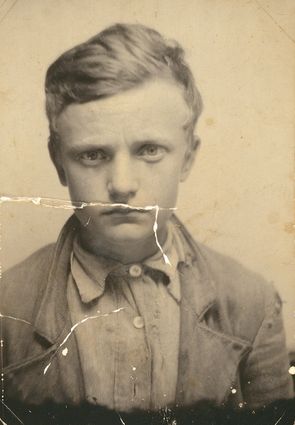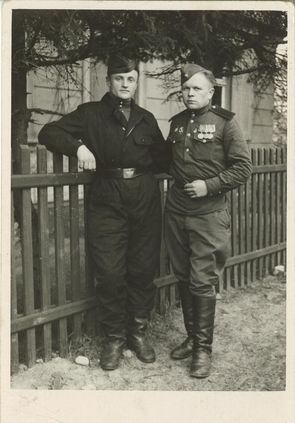Sunday, 22 April 1945
Teltow: Nikolaj Fjodorowitsch Galuschkow
"On April 22, all 37 people were taken out. We were counted and tied up. I was tied up with Ulyanchenko. Three more people were brought. So we became 40. Among them was a woman. And an old man, who was not in his right mind. We were taken away very quickly. There was a subway station nearby. I forget what it was called. We came to Friedrichstrasse... People looked at us with horror, we were completely emaciated. Half-skeletons were there... Then we changed trains again. Ostkreuz... Ostbahn... Großbeeren, I remember that."
"There was a very heavy guard until Teltow. We were led on foot ... A barrack. There was an SS unit there, which confronted us. We were positioned in front of the barrack. We only had trousers and a shirt for clothes. But we were searched thoroughly. Some time later one of the troops stepped forward: Quick! Tanks!
Then we had to line up. We clung together. An SS man hit me on the back of the head with the butt of his rifle and I went down. When the shooting began, everyone fell down, instantly. When I came to, there was silence, only the wounded moaning. I lay beside a pile of lifeless bodies and saw the first Russian tank rolling up. The saving Soviet army had reached Berlin."
In 1942 Nikolaj Fjodorowitsch Galuschkow is deported from the Russian city Perwomajskij to the German Reich. The 15-year-old is sent as a gravedigger to the "cemetery camp" on Hermannstraße in Neukölln. The forced camp is run by the 42 Berlin parishes. Day after day Galuschkow and his comrades have to dig graves and bury the dead throughout the city. When trying to escape with other members of a resistance group, he falls into the hands of the Gestapo. Galushkov is taken to the Gestapo house prison in Prinz-Albrecht-Straße, where he and 30 other prisoners are sentenced to death by firing squad after two months in prison, torture and interrogation.
On April 22, SS men take Galuschkow and his fellow prisoners by S-Bahn to Teltow, on the southern outskirts of Berlin. When the firing squad opens fire on the crowded group, Galuschkow is buried under the bodies of the others. He survives the murder at the last second, when Soviet tanks suddenly arrive - the Gestapo pulls out before Galushkov is even hit by the shots.
Immediately after the liberation, the Soviet military conscripts Galushkov to do his military service. Later he moves to Komi in the Arctic Circle, then to Orel near Moscow. He works as a locomotive heater and engineer.
Sunday, 22 April 1945
Heinersdorf: "At 4 pm we had regained our freedom"
"April 22 was a Sunday and a warm and sunny day. The roar had come much closer, allegedly the Russians were already 20 km away from us. The inhabitants of Osdorf gathered in front of their houses, they talked excitedly. Some carts were being prepared to head west, before the Russians surrounded Berlin. I had an afternoon off that day and hurried to get to Heinersdorf. I left my suitcase in the cellar. I just wanted to tell Frau Müller that I was leaving. As I had to pass the bathroom, I noticed that it was burning in the bathroom stove. Why had the miller lit the stove? I went inside. The stove door was open, and next to the stove, leaning against the bathtub, stood the empty frame of the large Hitler painting that had hung in the place of honor in the living room... I found Frau Müller on the way outside the house. She did not reply to my words that I was going to Heinersdorf. I left quickly - and never saw her again."
"From the early morning, everyone lived in great excitement. The Poles employed in Heinersdorf wanted to welcome the Russians in a dignified manner. The evening before they had persuaded old Ciesielska to sew a Polish flag on her hand sewing machine. In the morning they crept up the tower of the manor house and hung the flag on the mast. At 10 o'clock the Germans discovered the flag, but none of them had the courage to climb up the tower and take it down. Only the gendarme arrested Zdisiek Ciesielski, the main culprit. They didn't know what would happen to him. They said they would shoot him. But they couldn't do that anymore because the shooting was so close..."
"Suddenly some German soldiers ran along the house, sweaty and out of breath, then some more called for water, and suddenly we heard Russian calls. Again a sharp shooting broke out, this time right behind us, next to the barn, and two Soviet soldiers rushed into our apartment. They quickly asked for the Germans and ran on.
On April 22nd, at 4:00 p.m., we had regained our freedom."
Background:
In May 1941, Ludomiła Szuwalska was torn from her sleep in her Polish homeland by German gendarmes and sent to the German Reich for forced labor. She is first sent to a collection camp in northeastern Berlin. A few days later the family is taken to work in agriculture on a farm in Heinersdorf, south of the Berlin city limits. Once owned by a Jewish family, the estate complex was expropriated after 1933 and handed over to the Berlin city administration. Several Polish families already work there and live together in a very confined space. In June 1942, Szuwalska was separated from her family and moved to the farm of the Müller family, openly convinced of National Socialism, in neighbouring Osdorf
clever. Here she has to live without heating in a tiny attic room and work in the house and in the garden.

